NIKKOR - The Thousand and One Nights No.52

Nikon Fun Fun LensSet, Part 1 (Gugutto Macro/Fuwatto Soft)
With this tale, I wanted to go a little off the usual track and try introducing lenses with which Sato and Oshita were involved in developing. These lenses were not part of the NIKKOR lineup, neither were they Nikon Series E lenses. They were part of Nikon's Fun Fun LensSet. While many are likely unaware of these products, they were originally released in December 1995 as a set of three lenses. Sales were limited to Japan, and only 5,000 sets were manufactured.
by Kouichi Ohshita
I. Year-end round-table discussion
Twenty years ago, at the end of 1994, several people from optical design at the mid-points of their careers, including Mr. Sato and myself, were invited to participate in a round-table discussion. This discussion was held by Mr. Masaaki Tsukamoto of the Design 1, Camera Designing Department that existed at that time. As the leader of underwater camera design, Tsukamoto had successfully developed the NIKONOS RS, the world's first underwater autofocus SLR camera, and was struggling with product development in a new field. The objective of this discussion was to search for new material in the field of lenses.
"Does anyone have any interesting ideas?"
One of the participants answered, "How about a simple soft focus lens?" This was a time when established soft focus lenses that imitated the results achieved with the Vest Pocket Kodak were available. Mr. Sato and I were both influenced by these lenses, and we made our own soft focus lenses that were extracted from established lenses. It was somewhat of a soft focus lens boom.
"Soft focus lenses can be designed with two lens elements. If they are manual focus lenses, the structure is simple and they can be sold at a low price."
This statement resounded with Tsukamoto, who imagined products for use in the fields of education and teaching materials. He immediately expressed interest, commenting,
"That's a good idea! With a simple structure, they would be good educational materials for helping students to understand the structure of cameras and lenses."
"We could make them easy to disassemble so students could reassemble them."
"As they would be used with SLR cameras, I'd like to see users enjoy the differences in rendering achieved with a variety of lenses."
"Normal zoom is certainly convenient, but I'd rather have people use a fixed focal length lens."
"Also a super telephoto and ultra wide-angle lens."
After discussion of various topics, the round table ended on a friendly note.
One day, some time after the round table discussion, I received an unexpected phone call from Tsukamoto.
"I told my superiors what we discussed at the round table, and they are behind us one hundred percent. They want us to release not just a soft focus lens, but a set of lenses that includes a soft focus lens, a macro lens, a super-telephoto lens, and an ultra wide-angle lens. They've asked if we won't get right to work on designing simple lenses."
A day in December 1994 was the moment when we began developing these "fun fun lenses".
II. Planning "fun fun lenses"
The following four lenses were planned as special lenses that make the most of the characteristics of SLR cameras.
- 1.Soft focus lens
- 2.Fisheye lens
- 3.Macro lens
- 4.Super-telephoto lens
Our instructions were to develop and manufacture the lenses at a cost that would allow us to release each at a very reasonable retail price of around ¥5,000, detailed specs were to be entrusted to the optical design department, and while little priority was to be placed on performance, they should support printing at sizes of L (89 x 127 mm/3.5 x 5 in.) to 2L (127 x178 mm/5 x 7 in.).
While we didn't think we would have problems with the soft focus and super-telephoto lenses,
III. The Gugutto Macro (Macro 120mm f/4.5)

As you will see if you look at older macro (Micro) lenses, when the speed of the lens was slow, it was expected that performance could be preserved even when focusing is performed with the entire lens extended. The problem is with lens type. Ideally, a Gauss six-element structure or a Xenotar five-element structure, with which variations in performance according to distance are small and full compensation for all types of aberration is possible, would have been adopted. However, the cost of these types of structures made them irrelevant. The convex, concave, convex triplet structure is compact and provides full compensation for all types of aberration, but we didn't want to adopt that structure either. As the three lens elements are separated, assembly of the lens barrel is complicated, and positioning of each lens element requires great precision. As a two-group structure was possible, we began design based on a telephoto structure with which there is greater tolerance in the precision of front and rear group positioning. As compensating for distortion is difficult with a telephoto structure, the focal length had to be increased.
However, we did not think this was bad considering the most common application of macro lenses, that of photographing flowers.
The top cross-section in Illustration 1 shows the lens structure we designed. The lens is constructed of three elements in two groups with the front group comprised of two convex lens elements joined together to form a doublet and the rear group comprised of a lens element with weak negative power. Normally, the structure is comprised of a front group, in which two to three lens elements are separated, and a rear group consisting of two lens elements. However, by using both a doublet and a single lens element, assembling the lens was easier.
The primary factors we had to keep in mind when designing the lens were focal length and f/number. As the rear group is comprised of a single lens element, it was difficult to ensure performance at frame edges and provide adequate compensation for distortion. Therefore, we decided on a slightly longer mid-telephoto focal length of 120mm. In order to achieve clear rendering of the shapes of flowers with close-up shooting with a shallow depth of field, applying an aperture setting of around f/5.6 is standard. However, this was a simple manual focus lens with a fixed aperture value. It was vital that we achieve both optimal depth of field and make focusing easy. After testing an existing lens, we decided on an aperture value of f/4.5.
Though we easily decided with trial production that close-up shooting of approximately 1/3x was fine for photos of flowers, it was later indicated with trial production evaluation that 1/3x wasn't nearly enough. Therefore, the final product was rearranged and improved to achieve up to 1/1.4x.
IV. The Fuwatto Soft (Soft 90mm f/4.8)
However, we weren't quite finished designing the Gugutto Macro. The reason for this was a single comment from a younger designer. When talking about this lens as we were finishing it up, he said,
"I have a macro lens, and I would have no desire to purchase a macro lens that offered less performance, no matter how inexpensive it is. Don't you need something else that will encourage those who already own a macro lens to purchase this one?"
We felt as if we'd had cold water thrown on us. He was right. Macro lenses are the most popular fixed focal length lenses sold, and many people already owned one. We had to create a lens that even these people would purchase.
I came up with an idea while looking at the cross-section of this lens. Couldn't we create a soft focus lens by flipping the doublet in the front group (Illustration 1 bottom)? I immediately tried it and had a good feeling. I proceeded with revision of the design, comparing performance as a macro lens with a three-element structure, and performance as a soft focus lens with a two-element structure, and a lens that served as both the Gugutto Macro and the Fuwatto Soft was completed.
This is how a dedicated soft focus lens was added to planning of the "fun fun lenses", and its design was quickly completed. However, with completion of the Fuwatto Soft, mass production of dedicated soft focus lenses disappeared.
V. Lens rendering




As always, let's take a look at lens rendering using sample images.
Through even the mount on this lens is plastic, its outward appearance is well suited to that of cameras like the D700 and D810.
As shown in Photo 2, the lens can be disassembled into four parts. The main focusing unit lies at the back. At front right is the end of the lens barrel to which the lens unit is connected. The lens is normally used by attaching the lens unit to the bottom of the end of the lens barrel. If the lens unit is attached to the top portion, the Sarani Gugutto Macro state (even closer macro shooting at a reproduction ratio of up to 1/1.4x) is possible. The part at front center in Photo 2 contains the doublet that makes up the front group, and the part at front left contains the rear group with its concave lens element. Photo 3 shows the lens in its Gugutto Macro state, and Photo 4 shows the lens in its Fuwatto Soft state. By simply screwing parts onto the focusing unit, the lens is ready to use. In its Fuwatto Soft state, the remaining rear group will fit into a 35mm film cartridge case.

D700 Gugutto Macro 120mm f/4.5
Aperture: maximum
shutter speed: A-auto(1/400s)
ISO 200
White balance: AWB
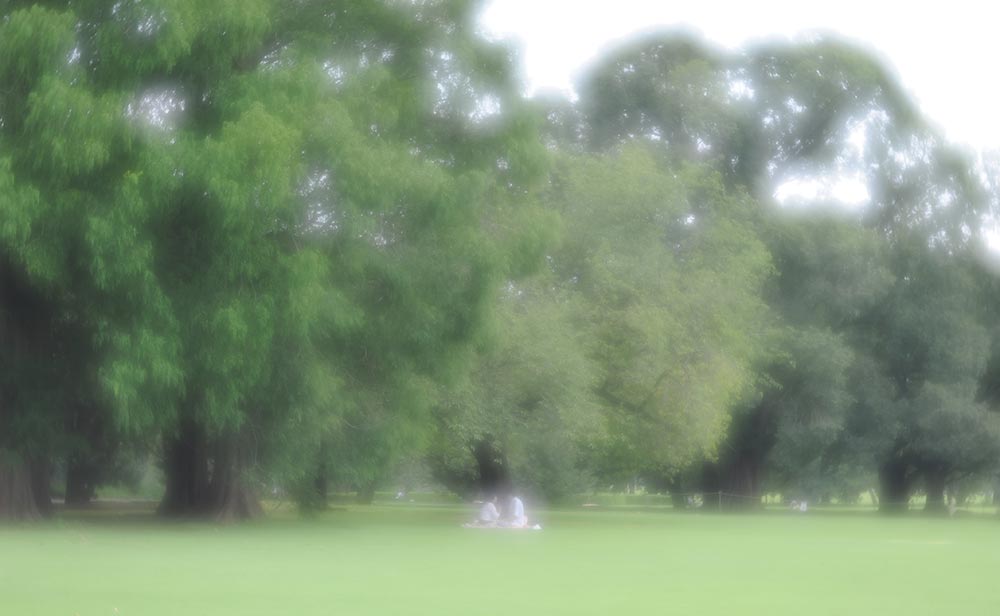
D700 Fuwatto Soft 90mm f/4.8
Aperture: maximum
shutter speed: A-auto(1/250s)
ISO 200
White balance: AWB
Sample 1 is a photo of an exterior surface of the Tokyo Metropolitan Government Building. As emphasis was placed on rendering at distances of less than one meter with this lens, you can see how resolution at the edges of the frame appears to be slightly reduced due to the effects of flare with distant scenes like this. On the other hand, there is hardly any visible distortion, despite the fact that the lens is a telephoto type lens. Because this was a macro lens, this is one of the characteristics about which I was particular.
Sample 2 shows rendering of a distant scene with the lens used in its Fuwatto Soft state. With ideal soft focus rendering, there is a core surrounded by flare that extends in a circular shape from that core, and the amount and shape of the flare are consistent over the entire frame. To achieve this, there must be no vignetting, and coma and astigmatism must be sufficiently compensated. With this lens, coma is nearly completely compensated, clearly resulting in consistent flare over the entire frame. On the other hand, astigmatism remains in the four corners, so that the average focal plane becomes flat. If you look closely, you will likely see that cores in the four corners appear to flow.
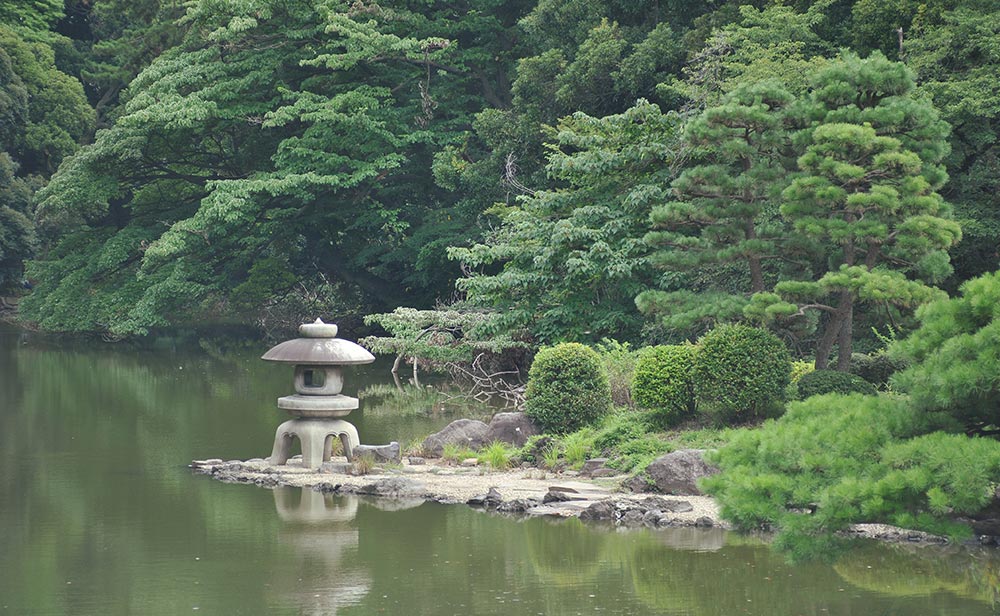
D700 Gugutto Macro 120mm f/4.5
Aperture: maximum
shutter speed: A-auto(1/200s)
ISO 200
White balance: AWB

D700 Fuwatto Soft 90mm f/4.8
Aperture: maximum
shutter speed: A-auto(1/500s)
ISO 200
White balance: AWB
Samples 3 and 4 are of the same medium to distant scene, one using the lens in its Gugutto Macro state and one in its Fuwatto Soft state. As the focal length in its Fuwatto Soft state (90mm) is slightly shorter than in its Gugutto Macro state (120mm), a broader area is captured with the Fuwatto Soft. Moreover, when shooting three-dimensional objects like this, the drop in image quality at the four corners of the frame visible in Sample 1 is hardly noticeable due to the addition of blur. As noted in the lens user's manual, the degree of flare exhibited by the Fuwatto Soft can be reduced by attaching an aperture. Personally, I think this lens exhibits a little too much flare at maximum aperture, so I would recommend stopping down the aperture to a diameter of about 15, or f/6.
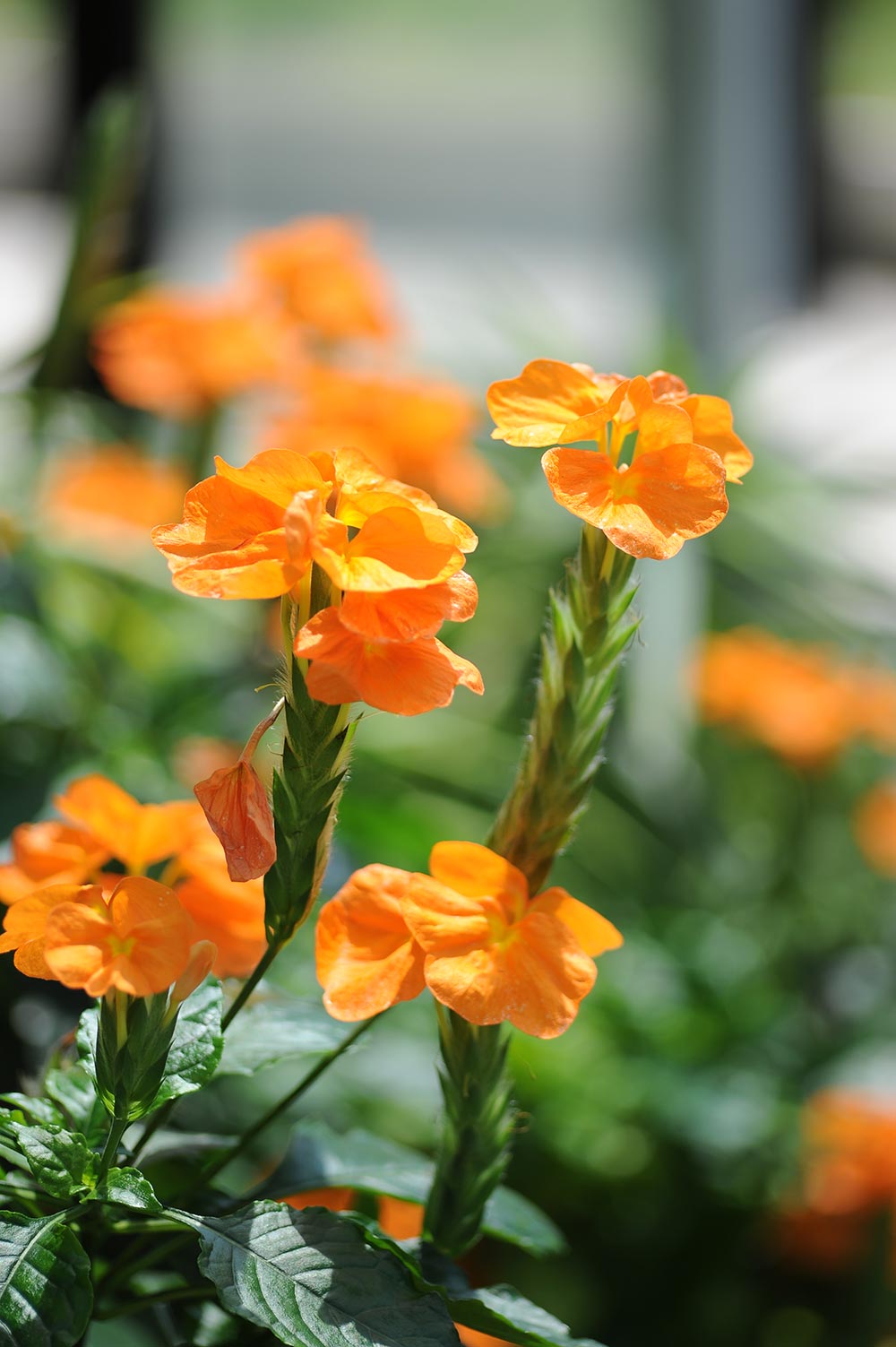
D700 Gugutto Macro 120mm f/4.5
Aperture: maximum
shutter speed: A-auto(1/400s)
ISO 200
White balance: AWB
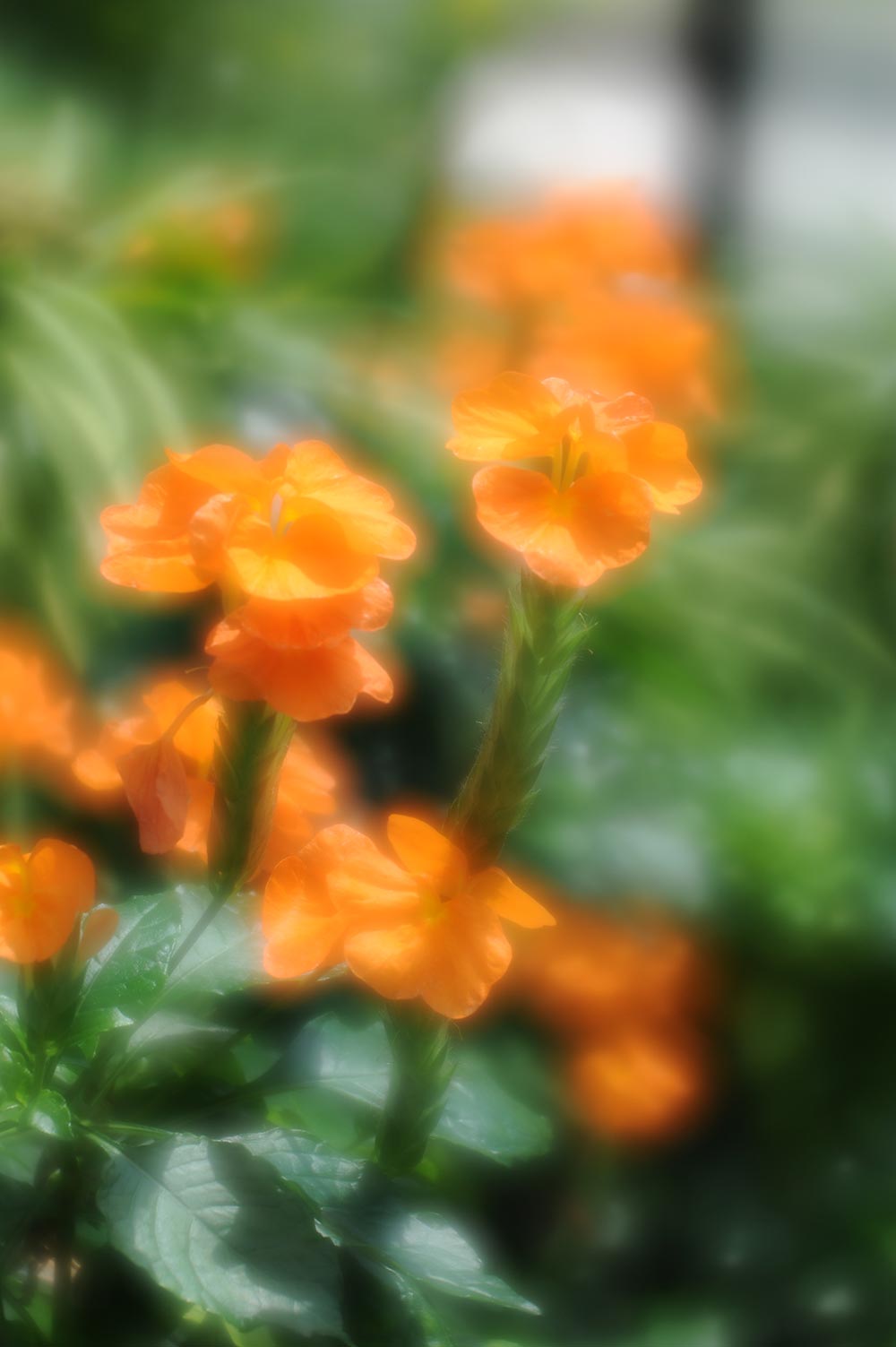
D700 Fuwatto Soft 90mm f/4.8
Aperture: maximum
shutter speed: A-auto(1/640s)
ISO 200
White balance: AWB
Samples 5 and 6 are photos of flowers captured at close distances. Sample 5 was taken with the lens in its Gugutto Macro state, and Sample 6 in its Fuwatto Soft state. Shooting distance was adjusted so that the flowers would be rendered at the same size. As the distance at which Sample 5 was captured is the distance at which rendering characteristics are maximized, sharp rendering is to be expected. However, as the lens has a simple structure comprised of three elements in two groups in its Gugutto Macro state, the curve of spherical aberration is great. The design did not sufficiently consider foreground and background blur characteristics. With some scenes, background blur may appear somewhat excessive. However, Sample 6 shows how the great amount of spherical aberration exhibited by the lens achieves beautiful background blur characteristics when used in its Fuwatto Soft state.

D700 Gugutto Macro 120mm f/4.5
Aperture: maximum
shutter speed: A-auto(1/320s)
ISO 200
White balance: AWB
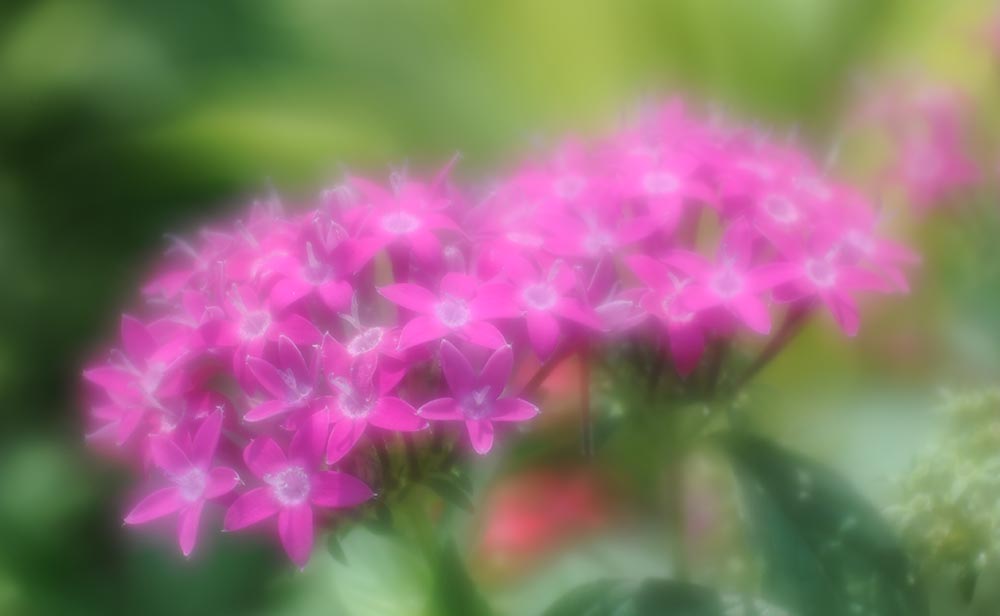
D700 Fuwatto Soft 90mm f/4.8
Aperture: maximum
shutter speed: A-auto(1/500s)
ISO 200
White balance: AWB
Sample 7, another flower photo, was captured at the closest focusing distance (approximately 1/3x) with the lens in its Gugutto Macro state, and Sample 8 was captured with the lens in its Fuwatto Soft state, with shooting distance adjusted so that the flowers would be rendered at the same size as those in Sample 7. Incidentally, extremely close-up shooting is possible with the lens in its Fuwatto Soft state. Performance drops with shooting at the closest focusing distance, but with three-dimensional subjects like this, that drop in performance is not very noticeable. To make subjects appear even larger, the lens unit can be attached to the front of the lens barrel for use in its Sarani Gugutto Macro state.
This tale is about a macro lens whose primary feature with initial design was an inexpensive price, but turned out to be the one that is also truly fun to use with the addition of a feature that allowed users to convert it to a soft focus lens themselves by disassembling and reassembling it in a different configuration.
This series of lenses was developed with the desire for many users to experience the fun and joy of lenses and photos. These lenses embody the fun we hoped to offer users.
There are a number of stories to tell about the remaining two lenses, but we'll save that for another time.

NIKKOR - The Thousand and One Nights
The history of Nikon cameras is also that of NIKKOR lenses. This serial story features fascinating tales of lens design and manufacture.

